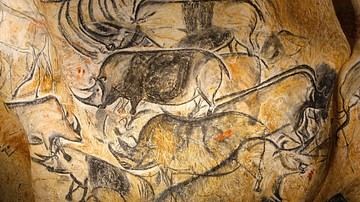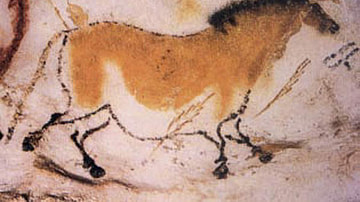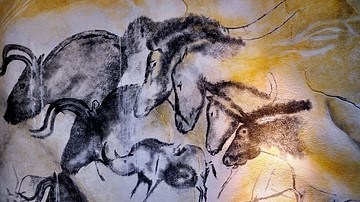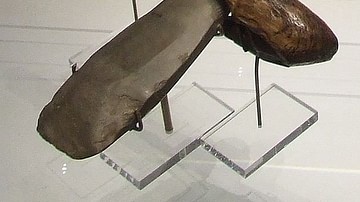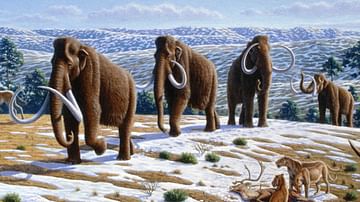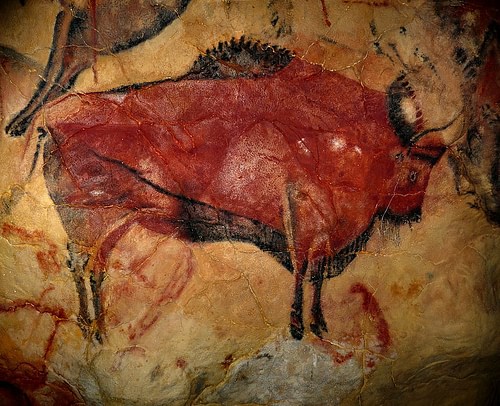
Altamira is a Paleolithic cave located in Santillana del Mar (Cantabria region) in northern Spain, containing prehistoric paintings. The cave was inhabited for millennia and so, besides Paleolithic cave art, it contains remains of the daily activities of the prehistoric population. It was declared a World Heritage Site by UNESCO in 1985.
Nowadays, the cave is 270 m long and the archaeological site can be found inside the cave, near the entrance, however, there are also remains outside since the original cave entrance fell down. The cave can be divided into three sections:
- the cave entrance
- the great room or polychrome room
- the gallery.
The entrance is the part where people used to live; archaeologists found there remains of animal bones, ash belonging to continuous fireplaces, and flint objects such as knives, axes, and flint fragments, indicating human activity in this part of the cave. Given the fact that archaeologists have found these types of remains located in different layers of sediments, it seems reasonable to assume that the cave was inhabited for long periods of time. The so-called polychrome or great room, painted in several colors, can be found in the inner part of the cave, where there is no natural light. The entrance and the polychrome room form a great hall, but since the cave is a narrow gallery there is little room for large spaces, except for the larger chamber. The end of the cave is a narrow gallery with difficult access, but it also contains Paleolithic paintings and engravings.
History of the Cave
The cave was discovered in 1868 by a hunter, Modesto Cubillas, who told Marcelino Sanz de Sautola, a nobleman in the region, about it. However, Sanz de Sautola did not visit the cave until 1875 and the first excavation works at the site only started in 1879. He found objects made of flint, bone, and horn, as well as colourants, fauna, and shells that allowed the dating of the cave paintings. These works only took place at the entrance of the cave. Sanz de Sautola published his Breves apuntes sobre algunos objetos prehistóricos de la provincia de Santander ("Notes on some prehistoric objects in the Santander region") a year later. At the time of the discovery, the main research on Prehistory was carried out in France by scholars who did not accept the authenticity of the paintings since they did not show the same patterns and features of those caves studied in France. Sanz de Sautola was considered a liar, and Altamira was forgotten. In 1902, E. de Cartailach, a French prehistorian, published Les cavernes ornées de dessins. La grotte d'Altamira, Espagne. «Mea culpa» d'un sceptique ("The caves decorated with drawings. The cave of Altamira, Spain. «Mea culpa» of a sceptical") and, from that moment, the cave gained a key role in the international prehistoric research.
Later, in 1903, H. Alcalde del Río continued the excavations and discovered two consecutive levels: one from the Upper Solutrean and another from the Lower Magdalenian, both of them belonging to the Paleolithic Period. These data were confirmed in the excavations made by Hugo Obermaier in 1924 and 1925, and J. González Echegaray and L. G. Freeman in 1980 and 1981, where they discovered a bigger complexity of the archaeological register. The studies and dating of the C14-AMS made in 2006 showed the different stages of human occupation of the cave. Eight levels were distinguished, from Middle Magdalenian (15,000-10,000 BCE) to Gravettian (25,000-20,000 BCE).
Paintings
Based on the archaeological research, experts assume that the paintings and engravings on the cave walls were made by the people who inhabited the cave during the different periods. Most of the paintings and engravings of Altamira, ranging from animals to hands, are located in the polychrome room. The oldest paintings are located on the right of the roof and they include horses, positive and negative images of human hands, abstract shapes, and a series of dots; mostly drawn by using charcoal. There are also 'masks' created by drawing eyes and mouth on the natural contours of the rock walls, which have been dated to the Lower Magdalenian period. However, the majority of the paintings from this period represent deer.
On the right of the roof, we can find the 25 coloured images of the cave (mostly in red and black): big representations of horses, paintings of bison, and a female deer that measures more than two meters. The drawing technique employed was engraving the wall with a flint object and, then, drawing a black line using charcoal. Afterwards, it was coloured with red or yellow. The details, such as hair, were made with a charcoal pencil while elements like eyes or horns were engraved. Although they may seem simple figures, bumps and cracks on the roof were purposely used to give volume to the animals.
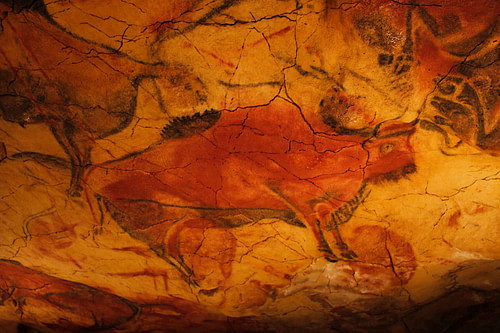
The narrow gallery contains a special set of masks representing animal faces, for instance, deer and bison. The technique employed is simple and astonishing at the same time. The artist took advantage of the natural contours and the perspective to create a whole face with simple elements such as eyes and lines representing the mouth or the nose.
Altamira Today
Nowadays, Altamira cave is closed to the public due to preservation problems. As said before, the entrance fell over and covered the cave, creating a stable climate inside that ensured the preservation of the paintings, but when it was discovered, the air started entering from the outside and caused changes in humidity and temperature. Furthermore, during the 20th century, walls and paths were built inside the cave to accept hundreds of thousands of visitors. All these changes affected the paintings, as well as the human presence. Between 1997 and 2001, measures were taken to control the state of the cave. In 2002, the Spanish National Research Council (CSIC) started an exhaustive conservation plan and, from 2011, an international committee of experts studies the feasibility of giving access to a restricted number of visitors without affecting the preservation of the paintings.
Even though the original cave cannot be visited, archaeological studies and experts made possible the re-creation of the cave that can be visited as well as the Altamira Museum which contains a permanent collection of objects from Altamira and other surrounding caves.
